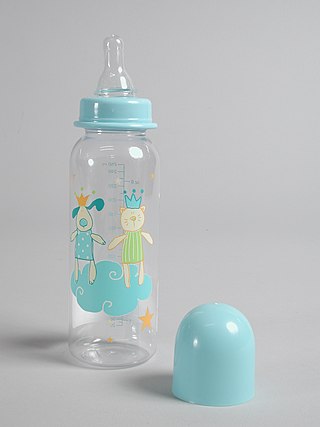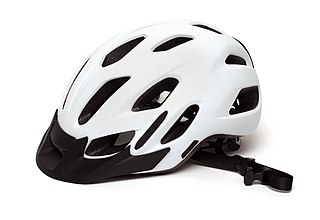
Infant formula, also called baby formula, simply formula, baby milk or infant milk, is an ultra-processed food designed and marketed for feeding to babies and infants under 12 months of age, usually prepared for bottle-feeding or cup-feeding from powder or liquid. The U.S. Federal Food, Drug, and Cosmetic Act (FFDCA) defines infant formula as "a food which purports to be or is represented for special dietary use solely as a food for infants by reason of its simulation of human milk or its suitability as a complete or partial substitute for human milk".

Sudden infant death syndrome (SIDS), sometimes known as cot death, is the sudden unexplained death of a child of less than one year of age. Diagnosis requires that the death remain unexplained even after a thorough autopsy and detailed death scene investigation. SIDS usually occurs during sleep. Typically death occurs between the hours of midnight and 9:00 a.m. There is usually no noise or evidence of struggle. SIDS remains the leading cause of infant mortality in Western countries, constituting half of all post-neonatal deaths.

A baby bottle, nursing bottle, or feeding bottle is a bottle with a teat attached to it, which creates the ability to drink via suckling. It is typically used by infants and young children, or if someone cannot drink from a cup, for feeding oneself or being fed. It can also be used to feed non-human mammals.

A child harness is a safety device sometimes worn by children when walking with a parent or carer. Child harnesses are most commonly used with toddlers and children of preschool age, though they may also be used with older children, especially if they have special supervisory needs such as ADHD or autism. Various types exist, though all are worn by the child and have a lead (tether) or rein which is held by a parent or caregiver. As child harness designs and purposes have evolved with cultural norms and parenting techniques, they have become subject to common debate.
The American Academy of Pediatrics (AAP) is the largest professional association of pediatricians in the United States. It is headquartered in Itasca, Illinois, and maintains an office in Washington, D.C. The AAP has published hundreds of policy statements, ranging from advocacy issues to practice recommendations.

Babywearing is the practice of wearing or carrying a baby in a sling or in another form of carrier. Babywearing has been practiced for millennia around the world. Babywearing is a form of baby transport which can be used for as long as mutually desired, often until toddlerhood and beyond. In the industrialized world, babywearing has gained popularity in recent decades. Part of the reason for this shift is due to the influence of advocates of attachment parenting.

A bicycle helmet is a type of helmet designed to attenuate impacts to the head of a cyclist in collisions while minimizing side effects such as interference with peripheral vision.

A pacifier is a rubber, plastic, or silicone nipple substitute given to an infant or toddler to suckle upon between feedings to quiet its distress by satisfying the need to suck when it does not need to eat. Pacifiers normally have three parts: an elongated teat, a handle, and a mouth shield which prevents the child from swallowing or choking on it.

Various methods of transport of children have been used in different cultures and times. These methods include baby carriages, infant car seats, portable bassinets (carrycots), strollers (pushchairs), slings, backpacks, baskets and bicycle carriers.
The International Code of Marketing of Breast-milk Substitutes is an international health policy framework for breastfeeding promotion adopted by the World Health Assembly (WHA) of the World Health Organization (WHO) in 1981. The Code was developed as a global public health strategy and recommends restrictions on the marketing of breast milk substitutes, such as infant formula, to ensure that mothers are not discouraged from breastfeeding and that substitutes are used safely if needed. The Code also covers ethical considerations and regulations for the marketing of feeding bottles and teats. A number of subsequent WHA resolutions have further clarified or extended certain provisions of the Code.

An infant bed is a small bed especially for infants and very young children. Infant beds are a historically recent development intended to contain a child capable of standing. The cage-like design of infant beds restricts the child to the bed. Between one and two years of age, children are able to climb out and are moved to a toddler bed to prevent an injurious fall while escaping the bed.

Childproofing is the act of making an environment or object safe for children. This reduces risks to a level considered acceptable by a society, an institution, or to specific parents. Childproofing may include restriction of children to safe areas or preventing children from reaching unsafe areas. This can be accomplished by the parent or by hiring a professional for assistance. Childproofing is gaining more prominence now that parents have greater access to information on child injury and a wide variety of products are available to help prevent it. It has become so top-of-mind for parents that even hotels and child-friendly resorts are offering "child-proof" rooms.

Gross motor skills are the abilities usually acquired during childhood as part of a child's motor learning. By the time they reach two years of age, almost all children are able to stand up, walk and run, walk up stairs, etc. These skills are built upon, improved and better controlled throughout early childhood, and continue in refinement throughout most of the individual's years of development into adulthood. These gross movements come from large muscle groups and whole body movement. These skills develop in a head-to-toe order. The children will typically learn head control, trunk stability, and then standing up and walking. It is shown that children exposed to outdoor play time activities will develop better gross motor skills.
BabyCenter is an online media company based in San Francisco, New York City, Chicago, and Los Angeles that provides information on conception, pregnancy, birth, and early childhood development for parents and expecting parents. BabyCenter operates 9 country and region specific properties including websites, apps, emails, print publications, and an online community where parents can connect on a variety of topics. Users of the website can sign up for free weekly email newsletters that guide them through pregnancy and their child's development.
Injury prevention is an effort to prevent or reduce the severity of bodily injuries caused by external mechanisms, such as accidents, before they occur. Injury prevention is a component of safety and public health, and its goal is to improve the health of the population by preventing injuries and hence improving quality of life. Among laypersons, the term "accidental injury" is often used. However, "accidental" implies the causes of injuries are random in nature. Researchers prefer the term "unintentional injury" to refer to injuries that are nonvolitional but often preventable. Data from the U.S. Centers for Disease Control show that unintentional injuries are a significant public health concern: they are by far the leading cause of death from ages 1 through 44. During these years, unintentional injuries account for more deaths than the next three leading causes of death combined. Unintentional injuries also account for the top ten sources of nonfatal emergency room visits for persons up to age 9 and nine of the top ten sources of nonfatal emergency room visits for persons over the age of 9.

The Consumer Product Safety Improvement Act (CPSIA) of 2008 is a United States law signed on August 14, 2008 by President George W. Bush. The legislative bill was known as HR 4040, sponsored by Congressman Bobby Rush (D-Ill.). On December 19, 2007, the U.S. House approved the bill 407-0. On March 6, 2008, the U.S. Senate approved the bill 79-13. The law—public law 110-314—increases the budget of the Consumer Product Safety Commission (CPSC), imposes new testing and documentation requirements, and sets new acceptable levels of several substances. It imposes new requirements on manufacturers of apparel, shoes, personal care products, accessories and jewelry, home furnishings, bedding, toys, electronics and video games, books, school supplies, educational materials and science kits. The Act also increases fines and specifies jail time for some violations.
Odón device is a medical device that assists during a difficult birth. The device consists of a plastic sleeve that is inflated around the baby's head and is used to gently pull and ease the head of the infant through the birth canal.
A baby jumper is a device that can be used by infants to exercise and play in. The original baby jumper consists of a hoop suspended by an elastic strap. More elaborate baby jumpers have a base made of hard plastic sitting in a frame and a suspended fabric seat with two leg holes, often with trays holding toys. The door jumpers lack the tray. There are also mobile play centers, which look very similar to baby jumpers, but which have wheels.
Infant and toddler safety are those actions and modifications put into place to keep babies and toddlers safe from accidental injury and death. Many accidents, injuries and deaths are preventable.
Newborn care and safety are activities and precautions recommended for new parents or caregivers. It is an educational goal of many hospitals and birthing centers to promote newborn care and safety as parents take their infant home.
















